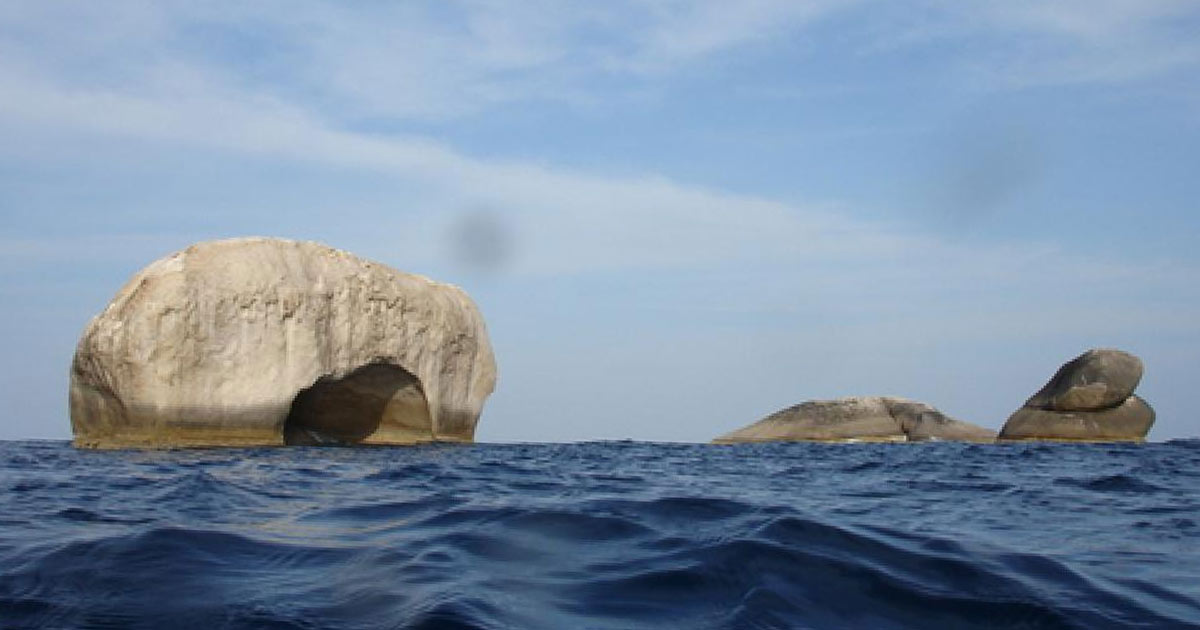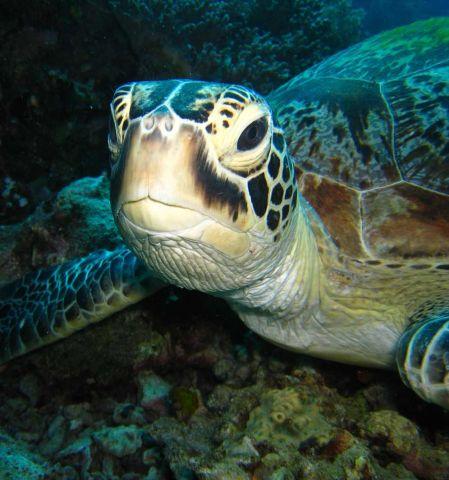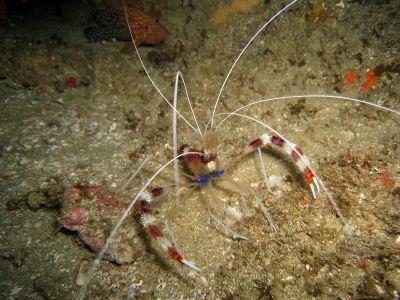Elephant Head Rock is the second most-recognizable Similan Island dive site. It is located in open water between the southern tip of Island 8 and the next island south, which has different names. It is an easily identifiable exposed rock which breaks the surface and looks like an archway at low tide. Being an exposed dive site it, offers excellent visibility in its deep waters. Currents and surface waves can be an issue, but they make it what it is - a great diving experience.
What's good at Elephant Head Rock?
- Swimthroughs
- Excellent visibility
- Better suited for experienced divers
- Sharks almost guaranteed

To clear up any confusion about the location of Elephant Head Rock, the best option is to look at our map below. It is located about 1 km south of Island 8's southern tip, at Beacon Point. The naming of the islands has changed in recent years, with some people calling Elephant Head Rock 'Hin Pusar' and others calling it Island 7. In the 1980s the authorities changed the classification of islands and took away its name and status, thus reducing the Similans to just 8 proper islands. The word 'Similan' means 9 in a local dialect, so the mid-sized island to the south (Koh Pabu) had its name changed to Island 7, and island 5 is now 5 & 6, because it has an isthmus, and becomes two islands at high tide.
 Green Turtle (Chelonia mydas) Photo by Henry and TersiaUnderwater at Elephant Head Rock, the site consists of dozens of huge granite boulders stacked upon one another, making a large pinnacle which comes all the way from the sandy seabed at 40 metres up to and above the surface. It is deeper on the eastern side, so it will depend on each diver's previous dives and experience as to where their Divemaster will guide them. All around the rocks and boulders divers should look out for several species of medium-size sharks, such as Whitetip Reef Sharks , Blacktip Reef Sharks, and Thailand's ubiquitous Leopard/Zebra Sharks. Although this dive site has plenty of water around it, the two huge filter feeders which the Similan Islands are synonymous with (Manta Rays and Whale Sharks) aren't seen here very often. This is no big deal though, because with so much reef life, great visibility and exciting swimthroughs, caverns, and canyons, Elephant Head Rock has some wonderful diving opportunities.
Green Turtle (Chelonia mydas) Photo by Henry and TersiaUnderwater at Elephant Head Rock, the site consists of dozens of huge granite boulders stacked upon one another, making a large pinnacle which comes all the way from the sandy seabed at 40 metres up to and above the surface. It is deeper on the eastern side, so it will depend on each diver's previous dives and experience as to where their Divemaster will guide them. All around the rocks and boulders divers should look out for several species of medium-size sharks, such as Whitetip Reef Sharks , Blacktip Reef Sharks, and Thailand's ubiquitous Leopard/Zebra Sharks. Although this dive site has plenty of water around it, the two huge filter feeders which the Similan Islands are synonymous with (Manta Rays and Whale Sharks) aren't seen here very often. This is no big deal though, because with so much reef life, great visibility and exciting swimthroughs, caverns, and canyons, Elephant Head Rock has some wonderful diving opportunities.
 Shrimp Photo by Henry and TersiaOn and around the granite rocks, hard and soft corals and sea fans flourish in the rich water currents. Thousands of marine fish and invertebrates make this their home, feeding ground, or somewhere to hide during the day. Various species of Moray Eels can be seen sticking their heads out of holes and crevices in the rocks and corals. These may look aggressive, but all they are doing is forcing water past their gills. Green Turtles and Hawksbill Turtles sometimes pay a visit to munch on coral at medium depths, so keep an eye out for them. In addition to the invertebrates such as Mantis Shrimps, Cleaner Shrimps, Boxer Shrimps, and Cuttlefish, divers are likely to see hundreds of bony fish at Elephant Head Rock. The list is endless, but a few common and interesting examples are as follows; Great Barracuda, Sweetlips, Giant Trevally, Blue-Ringed Angelfish, Fusiliers, Red Fire Gobies and Rockmover Wrasse. Several species of Snapper frequent this site. Others to be on the lookout for are Bigeye Bream, the amazingly vibrant Powederblue Surgeonfish and at least a couple of species of triggerfish; Clown & Titan. Finally, Elephant Head Rock has become quite well-known for a couple of fish species which exist nowhere else in the world. The endemic Andaman Sweetlips and the Andaman Jawfish are seen here from time to time.
Shrimp Photo by Henry and TersiaOn and around the granite rocks, hard and soft corals and sea fans flourish in the rich water currents. Thousands of marine fish and invertebrates make this their home, feeding ground, or somewhere to hide during the day. Various species of Moray Eels can be seen sticking their heads out of holes and crevices in the rocks and corals. These may look aggressive, but all they are doing is forcing water past their gills. Green Turtles and Hawksbill Turtles sometimes pay a visit to munch on coral at medium depths, so keep an eye out for them. In addition to the invertebrates such as Mantis Shrimps, Cleaner Shrimps, Boxer Shrimps, and Cuttlefish, divers are likely to see hundreds of bony fish at Elephant Head Rock. The list is endless, but a few common and interesting examples are as follows; Great Barracuda, Sweetlips, Giant Trevally, Blue-Ringed Angelfish, Fusiliers, Red Fire Gobies and Rockmover Wrasse. Several species of Snapper frequent this site. Others to be on the lookout for are Bigeye Bream, the amazingly vibrant Powederblue Surgeonfish and at least a couple of species of triggerfish; Clown & Titan. Finally, Elephant Head Rock has become quite well-known for a couple of fish species which exist nowhere else in the world. The endemic Andaman Sweetlips and the Andaman Jawfish are seen here from time to time.
Although this dive site can be a little challenging, with currents and surges between the rocks, it is well worth diving. The depth and clarity combine well with the swimthroughs and diverse marine life. The nearest island is just a kilometre or so away, but getting here has to be by liveaboard cruise or speedboat day trip. While this site is no good for snorkelling, other sites nearby are fantastic.



